Wikipedia’s article on alphabetization explains:
Advantages of sorted lists include:
- one can easily find the first n elements (e.g. the 5 smallest countries) and the last n elements (e.g. the 3 largest countries)
- one can easily find the elements in a given range (e.g. countries with an area between .. and .. square km)
- one can easily search for an element, and conclude whether it is in the list
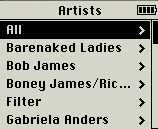 The first two advantages are things you almost never need to do with music libraries. And the third has been supplanted by now-ubiquitous search boxes: if you know what you’re looking for, you search; and if you don’t, an alphabetized list is not the way to find it.
The first two advantages are things you almost never need to do with music libraries. And the third has been supplanted by now-ubiquitous search boxes: if you know what you’re looking for, you search; and if you don’t, an alphabetized list is not the way to find it.
Web visionary Ted Nelson (<mst3k>Dr. Ted Nelson?</mst3k>) has been paraphrased as pointing out that “electronic documents have been designed to mimic their paper antecedents,” and that “this is where everything went wrong: electronic documents could and should behave entirely differently from paper ones.” If the folder metaphor is inadequate for digital documents, no wonder it’s so pitiful at handling music. The proximity between pieces of music in a library should least of all be based on the first letter in a band’s name – it’s as arbitrary as sorting them by the vocalist’s month of birth – yet this is how it’s universally done.
Music library organization needs to be re-thought from the ground up. We need to consider how it is that people used to listen to music before it was all on their iTunes. How are your CDs organized (or disorganized) on your shelf? How are they organized in your head? What is it that prompts you to listen to what you listen to when you listen to it? And how can we use computers to adopt and enhance these ways of thinking, rather than forcing us to think like computers?
Multi-Dimensional Sorting
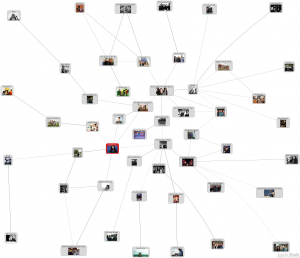 The most natural method for organizing music (if you can escape alphabetical thinking for a moment) is by similarity. Last.fm does this, and it is invaluable. When you are at an artist’s page at Last.fm, you feel that you are in that artist’s “neighborhood,” with links to similar bands, tags, listeners, and related groups. The Last.fm architecture was designed to manifest organic, bottom-up communities around bands and genres. This is an experience that cannot currently be replicated in any music player, at least not easily (with the possible exception of Amarok). But because Last.fm’s data is extraordinarily accessible, there are virtually no obstacles to incorporating this sense of “musical neighborhoods” into a piece of software.
The most natural method for organizing music (if you can escape alphabetical thinking for a moment) is by similarity. Last.fm does this, and it is invaluable. When you are at an artist’s page at Last.fm, you feel that you are in that artist’s “neighborhood,” with links to similar bands, tags, listeners, and related groups. The Last.fm architecture was designed to manifest organic, bottom-up communities around bands and genres. This is an experience that cannot currently be replicated in any music player, at least not easily (with the possible exception of Amarok). But because Last.fm’s data is extraordinarily accessible, there are virtually no obstacles to incorporating this sense of “musical neighborhoods” into a piece of software.
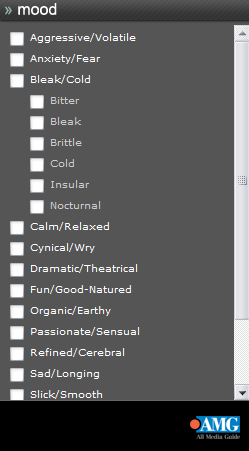 If you don’t already have an artist in mind whose neighborhood you’d like to browse, you probably at least have some idea of the kind of mood you’re after, and there are several approaches here. One (perhaps the least viable) is using Last.fm’s tags. These are actually less often concerned with mood than they are with genre, a taxonomy well-known as being inconsistent and, I would argue, misguided: When I want to listen to Lullatone, it’s not because I want to listen to electronic music; it’s because I want to listen to “whimsical,” “delicate,” “innocent,” “sparkling” music. Who cares what genre it is?
If you don’t already have an artist in mind whose neighborhood you’d like to browse, you probably at least have some idea of the kind of mood you’re after, and there are several approaches here. One (perhaps the least viable) is using Last.fm’s tags. These are actually less often concerned with mood than they are with genre, a taxonomy well-known as being inconsistent and, I would argue, misguided: When I want to listen to Lullatone, it’s not because I want to listen to electronic music; it’s because I want to listen to “whimsical,” “delicate,” “innocent,” “sparkling” music. Who cares what genre it is?
AllMediaGuide began a project called Tapestry some time ago, an application of their vast mood/situation/genre dataset. It is an ideal solution for browsing music, and its integration into desktop software would be hugely rewarding. It’s possible to simulate Tapestry with foobar2000 and some elbow grease, but the results are not as robust as they could be.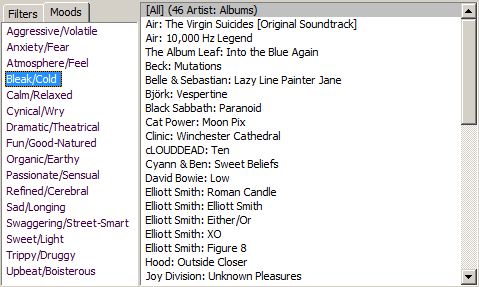
Again, if you already know what you’re looking for, it would be difficult to find it through these channels; but this is what search is for.
Personalization
We also need to consider the less objective and more personal reasons that music becomes relevant in specific contexts, analogously to the way in which CDs become disordered on one’s shelf. I, for instance, usually have about 20 albums littering the top of my receiver and speakers. These include, roughly, (a) stuff I just bought, (b) stuff I just listened to, and (c) stuff I haven’t bothered putting away because I know I’ll listen to it again soon.
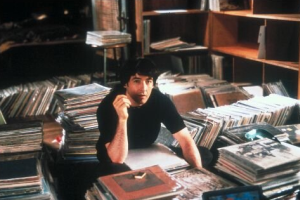 The main obstacle to browsing in this way is a prevalent shortcoming whose symptoms are far-reaching: the fact that music players “think” in terms of songs, not in terms of albums—or even in terms of artists, for that matter: My music software doesn’t know that these 38 songs are all by Electrelane; it just knows that their artist metadata is alphabetically adjacent. Sure, you can sort iTunes libraries by data such as “last listened” and “added”; and you can use CoverFlow to simulate a pale approximation of a flesh-and-blood record collection; but the only way you can sort albums or artists is alphabetically. I’ve written about the ways in which MP3Toys addresses this problem, and it remains a commendable pioneer in music management, but its difficulties (a steep learning curve, a buggy interface, a rapid release schedule) outweigh its advantages.
The main obstacle to browsing in this way is a prevalent shortcoming whose symptoms are far-reaching: the fact that music players “think” in terms of songs, not in terms of albums—or even in terms of artists, for that matter: My music software doesn’t know that these 38 songs are all by Electrelane; it just knows that their artist metadata is alphabetically adjacent. Sure, you can sort iTunes libraries by data such as “last listened” and “added”; and you can use CoverFlow to simulate a pale approximation of a flesh-and-blood record collection; but the only way you can sort albums or artists is alphabetically. I’ve written about the ways in which MP3Toys addresses this problem, and it remains a commendable pioneer in music management, but its difficulties (a steep learning curve, a buggy interface, a rapid release schedule) outweigh its advantages.
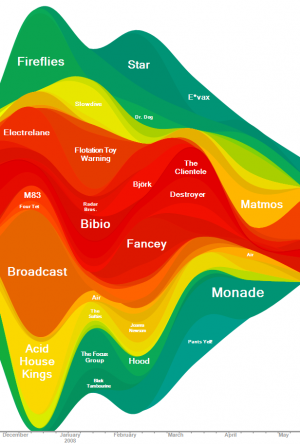 Browsing your own music library is a very impersonal experience, despite enormous potential for personalization. Rich info visualization “toys” such as Last.fm Extra Stats and LastGraph are seen as novelties, but would, in fact, be revolutionary as library browsing environments. There is nothing to prevent this from development, either; even users who are not plugged into Last.fm could have their listening history stored locally by their music software, which could then be used to generate small, cached, infinite-resolution SVG histograms, browsable by zooming, panning, and clicking. Far from being cumbersome and CPU-intensive, it would actually be rather elegant.
Browsing your own music library is a very impersonal experience, despite enormous potential for personalization. Rich info visualization “toys” such as Last.fm Extra Stats and LastGraph are seen as novelties, but would, in fact, be revolutionary as library browsing environments. There is nothing to prevent this from development, either; even users who are not plugged into Last.fm could have their listening history stored locally by their music software, which could then be used to generate small, cached, infinite-resolution SVG histograms, browsable by zooming, panning, and clicking. Far from being cumbersome and CPU-intensive, it would actually be rather elegant.
Continuing on the theme of chronology, what about a simple calendar charts view, with varying granularity by day, week, month, quarter? Presentationally, these charts could even be made easily to resemble vertical stacks of CDs, with spine art generated from a cropped cover image and overlaid text. This would arguably be eye-candy, of course, but just imagine how it would “feel” to see your music this way. If there’s one thing Apple’s been consistently right about, it’s that functionality is not at odds with a pleasant user experience, but rather that they are meant to be mutually supportive.
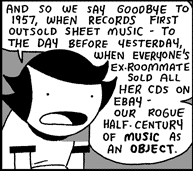 When I was helping to establish some playstamp tagging standards with the foobar community in 2005, it was jokingly suggested that when songs are played they be tagged with the current weather. Despite the sarcasm, I couldn’t help but think, “What a great idea!” I know my listening habits are affected by the weather, and I can’t imagine other people are not the same. There is, after all, a frequently-used “rainy day” tag at Last.fm.
When I was helping to establish some playstamp tagging standards with the foobar community in 2005, it was jokingly suggested that when songs are played they be tagged with the current weather. Despite the sarcasm, I couldn’t help but think, “What a great idea!” I know my listening habits are affected by the weather, and I can’t imagine other people are not the same. There is, after all, a frequently-used “rainy day” tag at Last.fm.
What about a histogram based not on play count, but on hotness values over time? What about artist similarity webs based not on Last.fm data, but on proximity of play times within your personal history? What about taking lessons from the DONTCLICK.IT project, BumpTop, and the pile metaphor for unprecedentedly fluid user interfaces?
What Now?
All the ingredients are there. Everyone is rapidly moving towards an exclusively digital music collection, and the technology is embarrassingly outmoded. Music has become a major component of computing, at levels once reserved for word processing and gaming. Our relationship with our digital music collections is poised for reinvention, a looming difficulty that has been made invisible by custom and habit. Digital music management is hell, and users have complacently accepted this.
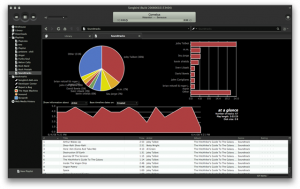 The obvious solution at this point is Songbird. Songbird’s media views (present since 0.5) allow more easily than ever for custom browsing environments. Previously the only way to alter your music browsing environment was to switch programs entirely; besides which, nearly all available programs simply mimic the well-known disk/directory views or iTunes’ browser pane view (which is just a glorification of a disk/directory view anyway). Songbird, on the other hand, boasts an unprecedented extensibility, coupled with media attention, ease-of-use, and the Mozilla platform, for which people have been developing extensions for ages (in computer years).
The obvious solution at this point is Songbird. Songbird’s media views (present since 0.5) allow more easily than ever for custom browsing environments. Previously the only way to alter your music browsing environment was to switch programs entirely; besides which, nearly all available programs simply mimic the well-known disk/directory views or iTunes’ browser pane view (which is just a glorification of a disk/directory view anyway). Songbird, on the other hand, boasts an unprecedented extensibility, coupled with media attention, ease-of-use, and the Mozilla platform, for which people have been developing extensions for ages (in computer years).
The prospects are thrilling and the potential for innovation is virtually limitless. Promisingly, there are some glimpses of where things might be headed for Songbird media views: Catalogue View demonstrates a novel visual presentation of your library, though it doesn’t do much in the way of organizational presentation; and Metrics Media Page is the beginnings of the kind of infovis view that could be (but currently isn’t) adapted to allow for actual navigation. Nevertheless, I have a bad feeling that this opportunity will be missed, as the status quo continues to obfuscate these possibilities.
Update: Part II
sydney says:
new website is ama sing
ps every time i listen to music it is based on the weather
hi jay
Jay says:
Thanks snute.
The weather affects my listening a lot, especially if it’s a big change, like waking up to a gray, wet, quiet day, or the first big snow of the year. Time of day is important too. And fluctuations in the NASDAQ average.
Walter says:
I don’t see why we are seemingly unable to have information overload in regards to metadata. I think there’s always something more I’d like to know about a song when I’m listening to it, but there are no real attempts at presenting the kilobytes of information that could be applied to a song just based on sleeve notes.
Take The Decemberists, for example, maybe I’d like to see other artists similar to them, other projects by members, quoted inspirations, observed inspirations, etc. Or maybe I’m listening to ‘Thriller’ and I’d like to see what else Quincy Jones has produced. A web based approach would have to be used in order to display items I don’t have personally.+]ertyu
Jay says:
Walter: Actually Songbird has a Wikipedia add-on that helps to provide that sort of context. Just the other day I was trying to come up with a better search solution than that, as Wikipedia isn’t really very comprehensive in the bands it covers. What if I’m currently listening to Grouper and I want to see, in one place, all her releases, notable critical commentary, related artists, etc.? I couldn’t even think of a proper “jumping off” point, some site that has even links to all those things. Last.fm is a decent solution, as part of its function is to serve as a wiki for every band, in theory, but you’d have to go elsewhere for critical context.
Since almost every band has a MySpace page now, that’s actually a good start, despite all the things I hate about MySpace. Lesser-known bands especially tend to link to reviews of their albums, blog announcements about new releases, and provide presskit-quality artwork and biographical data.
There’s actually a great article about what you’re describing that I meant to link to in this post:
Music says:
great article
Me says:
I have one easy reason why we all organize our music alphabetically.
Because many of us are tied to that archaic creation, the album. And many of us listen to, and judge, musicians based upon that criteria. I may be an old man at 26, but when I decide I want to hear The Who I put on The Who Sell Out, or whatever album I want to hear. I don’t care that it’s most closely associated with Britney Spears and then next.
There’s some value in organizing a music library with tags to easily create playlists based upon mood. That can be helpful, if you want mixed music. But why would I organize my music in any way but alphabetically? You provide an argument, but no evidence to back it up. I want to be able to find a band/album/song easily. Anarchy belongs in the streets, not in a library or music library.
When you do your laundry do you put your clothing away by % cotton, or do you put it away by type of clothing. I’m sure it will be very useful when you’re trying to find that specific pair of pants and have to dig through 20 shirts that happen to have a similar fiber makeup.
Jay says:
Thanks for the comment, “Me.”
There’s one simple answer to your question: If you want to listen to The Who, you put your mouse in that little search box in the corner and type “The Who.” If you’re using an alphabetical list to find artists and albums also, then that’s two tools redundantly serving the same purpose.
I’m not talking about making mixes, although that’s valuable to some people too. I, like you, am “tied to that archaic creation” as well — almost all of my listening is by full album. In fact I even mention in the article that one of the shortcomings of the most popular media players is that they don’t “think” in terms of albums.
What I’m trying to address is the problem of having too much music, and too diverse taste. I have 1,664 albums in my library, and I’m sure there are other people with thousands, if not tens of thousands, more. I don’t always know what I want to listen to; in fact, I’d wager that most of the time, I don’t know what I want to listen to. I know I want to listen to something, and that that something is in there somewhere, but I don’t know what it is.
If you asked me to list, from memory, all 1,664 albums in my library, I’d probably never make it past a couple hundred, and that would take days. If I’m in a situation where I have to figure out what to listen to, only the artists who are most familiar to me will spring to mind first, but that leaves me trapped listening to the same things over and over. What I’m after is a system that will know better than me what I want to listen to, based on my listening habits, artist similarity, etc., and which can help me to explore the things I have that won’t spring to mind.
A short story: yesterday I was perusing my physical CD collection (gasp!) to find a specific album I wanted to listen to while I walked to work. While looking for that one album, I found another album that I realized was more appropriate for my mood, for the weather, for the time of day, for how long it had been since I last listened to it…etc. Now, why didn’t I know that’s what I wanted to hear when I first approached my CD collection? It’s because my mind is very flawed and very finite, and can only know so much about what my library looks like.
The Who is a very well-known band, and one that I’m sure you’ve listened to a lot, so it’s easy for you to know that you want to listen to them. But wouldn’t it be a better system if, when you’re browsing (not searching) your library for The Who, you’d find them adjacent to The Rolling Stones, The Kinks, and Cream, rather than Wilson Phillips, Wilderness, and Wesley Willis?
It’s like I said in the article: If you know what you’re looking for, you search. If you don’t, then an alphabetized list is not the way to find it.
And I think your laundry analogy actually works in my favor. Shirts go together because they are of the same type of clothing, just as The Who and The Rolling Stones are the same type of music. I would never sort my clothes by their brand, for instance, yet this is analogous to sorting a music library by artist. I don’t care who made the clothes, I care that they are appropriate for the weather, that they match, that I haven’t worn them recently, etc.
Me says:
Hmm, I can buy the argument on principle, but I can’t think of a good implementation that wouldn’t be a ton of work to create and maintain. My library is only 400 albums or so by 70 musicians, so it’s still quite manageable by scanning through. Normally if I’m putting on music from my library I do know specifically what I want to play, if I’m in just a more general mood I’ll put on a Shoutcast station or something along those lines.
To a large degree that same classification can be done by good tags and a solid media player, plus it has the added advantage of being easy for someone else to browse and deal with on all sorts of players. If my wife is trying to play something on from my Tversity server on the PS3 she doesn’t need to know that I’ve classified The Violent Femmes as punk rather than folk, and in that case searching is inconvenient. There is the problem of knowing whether they’d be filed under T or V, but that’s more minor.
And even beyond the bands that don’t neatly fit, do you handle musical style by band, album, or song? If it’s just by band something like On Every Street by Dire Straits will end up massively misclassified. If it’s by album how do you handle Sticky Fingers by The Rolling Stones? And if it’s by song you then need a whole system of playlists to recreate the albums themselves.
Adam says:
I don’t agree with Ted Nelsons comments. Files and folders were a perfect start and they’ve been very successful. His ideas are a kind of “start again from scratch” mentality, and that’s simply not possible. We’ve gone too far already.
We need to complement existing interfaces with new accessibility and use the hardware at our disposal to do so. For example, the iphone has audio out and in, so how about analysing the “sound” of your music collection to fit the ambient sound level, or to give clues to the “mood” of where you are? Everything is net-enabled these days, and we’re not short of metadata to describe music. So these kind of connections should be effortless.
Technologically, we’re at a wonderful point in time where all these things are just becoming possible. We just need to get on with it and start making them. It’s almost as if music is on the verge of some audio equivalent of photosynth[1] being invented, and with the kind of metadata being formed by services like pandora.com[2] there are some exciting and unexpected music applications ahead.
[1] photosynth demo
[2] music genome
Jay says:
Thanks again for the comments guys.
As far as the “ton of work to create and maintain” goes, Adam’s right in that there’s metadata everywhere. He mentions Pandora, which is kind of a top-down approach to classifying music: “experts” meticulously categorizing everything they can by musical “genome.” I prefer Last.fm, however, with its empirical, bottom-up approach to classification, based on tracking actual listening habits. That, and they have a long history of making their metadata free and accessible with public XML services for just about everything. So, in short, you wouldn’t have to do anything; your music player would know which artists should be grouped together automatically.
I suppose when it comes to a mouseless/keyboardless interface like the PS3 (or a portable player, come to think of it), alphabetical lists do make searching easier than having to “type” artists’ names; so in those cases, I’d have to concede that you’re right, Me. And I suppose what I’m describing will be useful only to people with large libraries like myself. But for those of us who have those large libraries, mining our collections is incredibly frustrating, especially when you realize that there are so many opportunities to create browsing environments that are not only more intuitive and functional, but fun as well.
Adam’s also right that these kinds of innovations should be “effortless,” yet it seems as though nobody’s innovating. Nobody has been thinking beyond the alphabetized list until recently, with Apple’s “Genius” feature and Microsoft’s “MixView” — and both of these seem to be efforts to sell music, not primarily to make your library more dynamic.
All it would take is a room of user-interface experts experimenting with different models to “push” your music to you in interesting new ways, based on artist similarity, based on your listening history, based on mood, based on time of day, based on time of year — hell, based on the weather and on news feeds. It wouldn’t merely be flashy; it would, I think, profoundly change the way you interact with your music library.
Me says:
All it would take is a room of user-interface experts experimenting with different models to “push” your music to you in interesting new ways, based on artist similarity, based on your listening history, based on mood, based on time of day, based on time of year — hell, based on the weather and on news feeds. It wouldn’t merely be flashy; it would, I think, profoundly change the way you interact with your music library.
The groundwork has sort of been laid for that already. There are many music services that offer tailored experiences…rate a song up and you get it more often (sometimes even similar songs more often). Rate it down and you never hear it again.
You could create a personalized system where you identify your mood, or what sort of music you’re interested, or what color socks you’re wearing…then rate songs up or down. In theory, with time, it could simply train itself to serve music based upon those factors on just your hardware.
To do it well would be expensive, a central database could combine the data from people, perhaps sort it by overall preferences (for instance, sometimes I like The Distillers…so perhaps my opinion is held to be less relevant on when I want to hear Paul Simon for someone who just listens to light rock).
I think the problem is that a truly intelligent, easy to use, service would take a massive amount of infrastructure. It would have to deal with music on a song, album, and artist level…tying all of those to musical taste and emotional description. It would either have to be based upon a sales model, or be done by a company with enough market penetration (Read: Google) to mine data at a very massive rate.
Me says:
Oh, and I should admit there’s one huge reason I cling to a simple alphabetical artist\album\songs classification system.
I dual boot, and like running very stripped down music players. I detest iTunes. On my Linux partition I like XMMS. Windows…I’ll admit I still love Winamp. I haven’t broken free from that interface. I know there are all sorts of library based music players for Linux, such as Amarok. I know there are all sorts of fancy library based players for Windows…but I don’t know that I’ll ever get past straightforward music players.
Shazback says:
This is a very interesting article, but I feel that the problem is akin to organising books.
If you associate artists, how do you link bands like (just taking the first one I think of) The Beatles? Are they close to the Beach Boys, the Status Quo, ELO, the Monkees, and even Britpop like Oasis? Are they close only to some? The Beatles started out with Please Please Me and Help!, but finished with Sargent Pepper’s… If one considers the Beatles as a whole, they become linked to so many bands there’s little point in linking them in such a way… I only like their Psychedelia albums, and I definitely don’t like their early pop tunes. I have no interest in the Monkees, but I like the Status Quo and the Beach Boys. To go back to the author comparison I made earlier, who is Wilde close to? The Portrait of Dorian Gray and the Ballad of Reading Gaol are so dissimilar (and then there are all his plays that are once more a different tone) that he can be linked with far too many people to make any links useful to someone who is only interested in the Ballad of Reading Gaol (or the Portrait of Dorian Gray).
So what about albums? That’s already a better proposal, since it would make an artist’s evolution clearer. “Help!” and “Sargent Pepper’s” can be linked because it’s the same band, but at least groups like the Monkees will be kept away from Sergeant Pepper’s.
Unlike you, I listen more to just one track of an album at a time. Create playlists, play them. So I wouldn’t be very interested by grouping music by album. After all, I feel that between Lucy in the Sky with Diamonds, She’s Leaving Home, A Day in the Life and Sergeant Pepper’s Hearts Club Band, there are differences so great I don’t always feel like listening to all of them one after another (or in such a short time frame). So I’d be a proponent of linking each song… I think you can see where this is going. It’s going to be a nightmare to link songs individually, and even harder to recognise if said link is worth it (how many hundred of thousand of songs imitated Lucy in the Sky With Diamonds’ sound, and how many were any good?).
The problem is that liking or disliking (or being indifferent) to a track seems to me as something very subjective. I think a lot of people (or at the very least myself) like music that is very diverse. From Joy Division to the Happy Mondays, Dizzy Gillespie to Bill Haley, and countless others, with each time tracks that I like more and others that I like less… What does “bleak/cold” mean when talking about Louis Armstrong? Is it the same as for A.I.R and Grandmaster Flash? All these appreciations are ultimately extremely personal. Last.fm suggest I listen to Alain Souchon, Luke, Renan Luce, Cali, BB Brunes, Francis Cabrel and Bruel… Except I already know all of them and I dislike them. Yes, they sound like some artists I listen to (funnily enough, not artists I listen to a lot, so perhaps last.fm’s ranking system needs to be re-tuned), and lots of them have fans who are also fans of bands I like. But when my top fifteen only has three french-language artists (according to last.fm), why suggest so many french bands, and -NO- english-language bands (nine of those fifteen)?
These ideas are very interesting, but I think I’ll stick to making my own playlists, and every now and then either going straight to a track/album/artist I want to listen to, or just putting on the shuffle mode.
I’ve drifted away from the book comparison I started with, but I do find it similar. We don’t rank books by the author’s name, and organising music by the name of the composer/performer is also not the best. However, once the topic is broadly defined (novels, refence books, psychology, philosophy or rock, classical, electronic) it becomes slightly futile to attempt to continue classifying them since any further division will likely prove more confusing for the user than helpful. If Victor Hugo’s books were separated more than between “plays”, “novels” and “poetry”, would it be useful? In my opinion, no. (However, I still find these different “organisations” mightily interesting, and perhaps one day I’ll feel compelled to use them and find them brilliant!)
Jay says:
Thanks Shazback. One reason that we’ve had to stick to alphabetizing books is that, in most collections, there’s only one copy of each of them. So if you were to want to sort by “genre,” you would have to make very subjective choices in organization. What’s great about digital collections is that they lend themselves to what’s called a “flat hierarchy” — something I talk about with regards to music elsewhere here and here. Items can be duplicated with aliases and placed under multiple categories. Kind of like if you’re looking in the new releases section at Blockbuster and somebody has taken the extra step of making a shelf of old classics by the same director of a new release, or with the same lead actor. It’s those rich cross-sections that are missing from our music libraries.
Ideally under a system like this you will find The Beatles next to The Beach Boys and next to Oasis. Or, if we want to get really tricky, all three of those bands will have the same X and Y values, but Oasis may have a different Z value as a result of their being influenced by ’60s pop, and not a part of it themselves. A 3D mapping like this makes things a little more complicated than is practical, but it’s worth thinking about.
Last.fm may be recommending bands to you that you don’t like, but if the Last.fm similarity data were applied to your own library, then you would only be presented with things you presumably like (since you own them). And, although Last.fm may not be perfect, it’s probably the most thorough and available dataset out there — and, in my opinion, it’s pretty damn good.
If you prefer to listen on a song-by-song basis, then yes, I admit that this becomes a more difficult problem to handle. AllMusic and Pandora do possess mood-centric metadata at the song level, but don’t make it publicly available. Without their cooperation, personal tools might be the only way to attack this problem, such as Moody for iTunes or (the now defunct) MoodLogic.
On the album level we only have mood-centric metadata from AllMusic. This is subjective, of course, and even dealing with full albums on a mood-based level is methodologically questionable, since many albums are all over the place in terms of mood. So we either (a) just accept that this is a fundamental problem with describing albums by mood, or (b) devise some algorithm to apply the moods of every song on an album to the album as a whole, which would make an album’s inclusion under a particular mood not binary — i.e., either it is or is not “sad” — but on a gradient — i.e., it is 80% “sad.”
Personally, with my hack-ish implementation of these moods on the album level in foobar2000, I find that I get very good results. And though there are albums that are emotionally all over the map, there are also many that are emotionally pretty stable; think about Loveless or Slanted and Enchanted. Furthermore, even if every song on an album is not perfectly described by the moods used to describe the album, I would argue that in most cases, albums as a whole, even if they vary in mood, either do or do not complement the mood of a situation. AllMusic will often describe albums that are emotionally erratic as “cerebral” or something, rather than strictly “bleak.” Check out the full list of AllMusic’s mood descriptors and you’ll see that it’s actually an admirably nuanced system.
On the artist level, this is where mood breaks down. Although summing up an album by mood is a dodgy but viable endeavor, the same can’t be said for artists. Browsing artists by mood would be fruitless, so I don’t really propose it. This is why a 2D genre/style map is in my opinion the best way to organize artists. Last.fm already does this with their “Islands of Music” experiment, which, as an interface to a desktop music application, would be bliss.
Grandmaster Flash is described by AllMusic as being: Boisterous, Brash, Party/Celebratory, Confident, Bravado, Playful, Visceral, Freewheeling, Energetic, Gritty, Intense, Exuberant, Ominous, Provocative, Aggressive, Rousing, Somber, Confrontational, Cathartic, Dramatic, Searching.
Louis Armstrong is described by AllMusic as being: Warm, Lively, Freewheeling, Carefree, Amiable/Good-Natured, Earthy, Cheerful, Joyous, Playful, Boisterous, Earnest, Romantic, Gleeful, Rousing, Energetic, Fun, Confident, Whimsical, Exuberant, Elegant, Rollicking.
Where would this put these artists in AllMusic’s more general mood categories like “Fun/Good-Natured” and “Slick/Smooth” from their Tapestry project? I don’t know — that’s too much data to extrapolate a quick guess from. But even if they were neighbors in mood, so what? Like I said, if you have a decent mood categorization system, genre becomes irrelevant. Hell, right next to each other in this image I have cLOUDDEAD (experimental hip-hop) and Cyann & Ben (psychedelic folk-rock) under Bleak/Cold. And I can tell you, yes, both of those albums are pretty bleak and pretty cold, and if one would complement my mood at a given moment, there’s a good chance the other would as well, despite the two being from vastly different genres.
This conversation too has strayed from another major point I was trying to make in the article, which is that your own personal play history within your music player provides a very rich dataset to be exploited. I myself have spent some time developing an algorithm to describe what I call “Hotness,” which looks at how frequently and how recently you’ve listened to any given song to give you a snapshot of the artists that are more or less your “current favorites.” And despite being admittedly rudimentary, it still produces vastly more interesting results than simple “last played” and “number of plays” sorting or “smart playlists” (“smart” — hah!). And I’m sure somebody smarter than myself could invent far more compelling ways to look at your library that are based on your play history.
There are a lot of ways this could all go, and none of them is perfect. But I think it’s important to start thinking about this, and for people to start at least attempting to create a richer, more dynamic interface to our libraries. I’m not an expert programmer by any means, and am just now trying to verse myself more thoroughly in Javascript and XUL to start working with Songbird. But I was hoping to at least inspire conversation with this post, and to potentially reach the right person who both shares my ideas about what these solutions might look like, and knows enough to implement them somehow.
Me says:
One reason more hasn’t been done along those lines might be that anyone who had the knowledge and talent to do something like that on a large scale would be tremendously valuable to the advertising industry.
Perhaps that’s somewhere to look for inspiration in the design. On the surface a system like Google Adsense seems unrelated, but their systems do the sort of large scale data mining and heuristic processing.
Ross says:
I’ve found this article long after the fact, but it’s still one of the leading results for doing a search on trying to organize music intuitively. I couldn’t find any contact info, but I was wondering if there have been any updates since this article was written? While I think my music tastes are completely different, I face a similar problem. I just want to be able to select music by mood / imagery it invokes and hit random play, not have to think much about it. To compound problems I’m a big fan of game soundtracks, many of which never had any sort of official release, so there is no album to reference, the burden for organizing is entirely on me. I’m willing to put time into organizing it, but I’m still trying to come up with a system that I think would work for me. The ideal solution would be for me to have a music “map” where I could just select “regions” to play from, but I don’t know of any system like that. Any feedback would be appreciated.